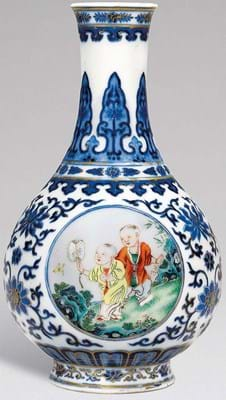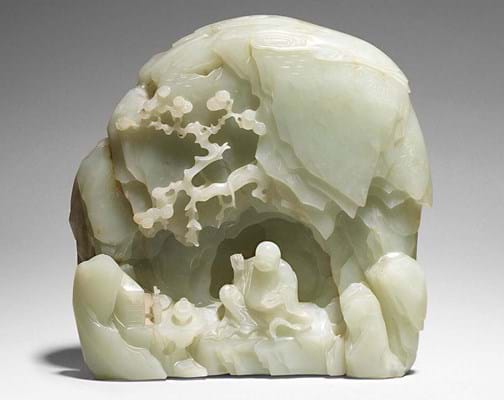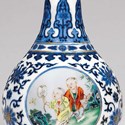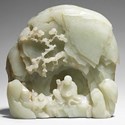Christie’s posted the top lot among the ‘big three’ salerooms selling a pair of Qianlong (1735-96) ‘daji’ double gourd form plaques for £610,000 (estimate £120,000-180,000) at a £4.9m sale on November 5.
These deluxe imperial confections, bursting with auspicious messages expressed through the careful choice of motifs and rebuses, were offered for sale by a direct descendant of a China trade merchant. The pair also received the award for the most outstanding work of art from an auction house (also see AAL prize winners story).
A £4.7m sale titled Imperial Porcelain – A Private Collection on November 6 produced Sotheby’s best-seller. A 7in (18cm) Qianlong mark and period yingxitu vase painted with roundels of boys playing with goldfish and butterflies – a scene representing prosperity, wealth and longevity and the desire for male offspring – doubled hopes to sell at £420,000.
Last sold in 1995, the vase was formerly owned by the celebrated Chicago collector Stephen Junkunc III (d.1978).
On the same day, the firm’s £4.5m mixed-vendor sale of Important Chinese Art was topped by a 7in (17cm) Qianlong mark and period copper-red decorated moonflask intricately painted with a complex geometric design after a Yongle prototype took £190,000. It is one of three similar vessels collected by Robert C Bruce (1898-1953). Two others were sold by Sotheby’s in 1953 and 1979 with this one coming by descent with an estimate of £30,000-50,000.
Catalogued as late Qing or Republican, a pair of cloisonné enamel stools from the estate of the Littlewoods heir and arts patron Sir Peter Moores leapfrogged a £10,000-15,000 guide to bring £235,000.
Bonhams’ £1.7m Chinese art sale on November 7 was topped by two good jades from contrasting periods. A 6½in (16cm) Qianlong pale green jade luohan boulder was on the market for the first time since it was acquired in Hong Kong in the 1950s. It is carved with two of the Sixteen Luohans in landscape grottos – identified in inscriptions as Angaja (holding a flywhisk) and Kalika (a bell in each hand). It sold at £200,000, 10 times the estimate.
A 7in (18cm) pale green jade figure of the bodhisattva of wisdom Mahasthamaprapta was made in the 13th or 14th century at the end of the Song or the beginning of the Yuan period. Offered by descent from an English private collector with hopes of up to £120,000, it took £180,000.
Japanese works of art

Mitsukuni Defying the Skeleton Spectre Conjured Up By Princess Takiyasha by Utagawa Kuniyoshi – £160,000 at Sotheby’s.
The top Japanese work of art sold last week came in a Bonhams sale on November 7 titled Masterpieces of Japanese art from a Royal Collection.
Sold at £300,000 was a large-scale 2ft x 15in (61 x 38cm) Shibata Zeshin (1807-91) lacquer panel of a farmhouse in the snow at Sano. The scene, taken from the Noh play Hachi no ki, shows the impoverished courtier Tsuneyo Genzaemon offering hospitality to Lord Hojo Tokiyori disguised as a wandering monk.
It is signed in gold maki-e characters Gyonen nanajunana Koma Zeshin sei (Made by Koma Zeshin, aged 77) and is dated 1883. An accompanying receipt records its sale in Japan in April 1926 for ¥3750 but it has a much more recent auction history, having been sold by Bonhams in November 2014 for £700,000.
The previous day Bonhams sold the second tranche of a collection of netsuke formed by Robert Huthart, the Newcastle-born manager of the Hong Kong department store conglomerate Lane Crawford.
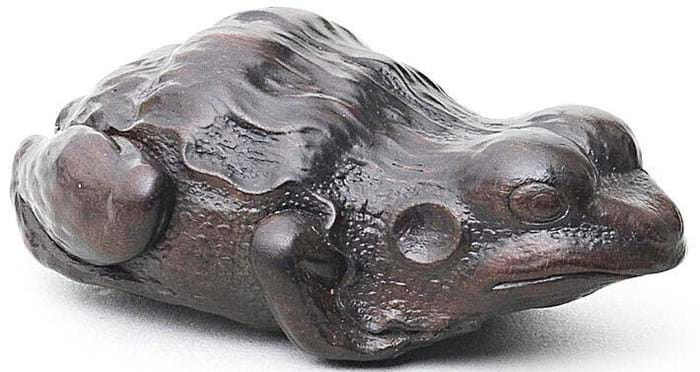
A kurogaki netsuke frog by Seiyodo Tomiharu from the Robert Huthart collection – £16,500 at Bonhams.
His focus was the distinctive netsuke produced by late 18th and early 19th century carvers based in the seaboard province of Iwami (present-day Shimane Prefecture). A kurogaki (black persimmon) carving of a frog by Seiyodo Tomiharu (1733-1810), formerly in the Anne Hull Grundy collection, topped the £300,000 sale at £16,500.
The November 5 £2.2m sale of Fine Japanese Art at Sotheby’s recorded bids of £160,000 each for impressions of well-known Edo ukiyo-e woodblock prints. These were Katsushika Hokusai’s Shower Below the Summit (also known as Black Fuji) c.1831 and Utagawa Kuniyoshi’s depiction of a monstrous skeleton spread across a three-sheet triptych. The latter, sold for almost 10 times the estimate, was untrimmed, an early state and still brightly coloured.
More sales of Asian art are being held early this week.


